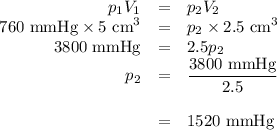
Physics, 23.05.2020 21:58 hehelupesss5245
Se tienen 5 cm3 de aire encerrado en una jeringa, siendo p = 760
mmHg. Para reducir el volumen que ocupa el gas se ejerce presión,
manteniendo constante la temperatura:
a- Calcula qué presión habrá que ejercer sobre el émbolo de la
jeringa para que el volumen sea una décima parte menor que el inicial.
b- ¿En cuánto debe aumentar la presión para que el volumen se
reduzca a la mitad?

Answers: 2


Another question on Physics

Physics, 21.06.2019 23:30
Part a determine the magnitude of the x component of f using scalar notation. fx f x = nothing lb request answer part b determine the magnitude of the y component of f using scalar notation. fy f y = nothing lb request answer part c determine the magnitude of the z component of f using scalar notation. fz f z = nothing lb request answer provide feedback figure1 of 1a force vector acting on a ring attached to the ground is shown in the xyz space together with its x, y, and z components lying on the corresponding positive axes. the ring is located at the origin. force f is located in the first octant. f makes an angle of 60 degrees with its x component and an angle of 45 degrees with its y component. a force vector acting on a ring attached to the ground is shown in the xyz space together with its x, y, and z components lying on the corresponding positive axes. the ring is located at the origin. force f is located in the first octant. f makes an angle of 60 degrees with its x component and an angle of 45 degrees with its y component.
Answers: 2

Physics, 22.06.2019 16:40
The astronauts on the space shuttle flights experienced an acceleration of 29 m/s2 (about 3 "g's") during lift-off. what upward force must the astronaut's seat apply to the astronaut in order to cause this acceleration? assume the astronaut's mass is 70 kg, and compute this force when the acceleration is near the earth's surface so their weight equals latex: mg m g .
Answers: 3

Physics, 22.06.2019 18:00
According to newton’s law of universal gravitation, which statements are true? as we move to higher altitudes, the force of gravity on us decreases. as we move to higher altitudes, the force of gravity on us increases. as we gain mass, the force of gravity on us decreases. as we gain mass, the force of gravity on us increases. as we move faster, the force of gravity on us increases.
Answers: 2

Physics, 22.06.2019 19:00
The particle p starts from rest at point a at time t = 0 and changes its speed thereafter at a constant rate of 2.8g as it follows the horizontal path shown. determine the magnitude and direction of its total acceleration (a) just before point b, (b) just after point b, and (c) as it passes point c. state your directions relative to the x-axis shown (ccw positive) and choose the angle with the smallest magnitude.
Answers: 1
You know the right answer?
Se tienen 5 cm3 de aire encerrado en una jeringa, siendo p = 760
mmHg. Para reducir el volumen...
mmHg. Para reducir el volumen...
Questions






Mathematics, 16.10.2019 04:10

Biology, 16.10.2019 04:10


Chemistry, 16.10.2019 04:10



Biology, 16.10.2019 04:10




History, 16.10.2019 04:10




Mathematics, 16.10.2019 04:10






